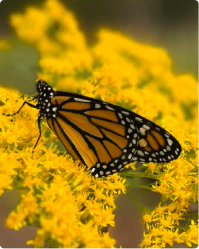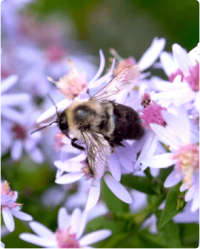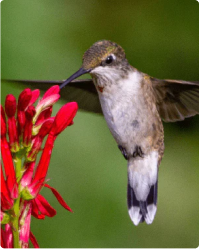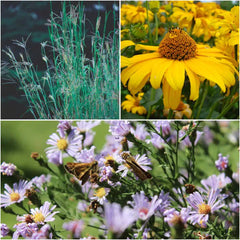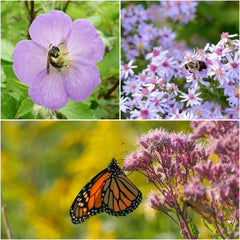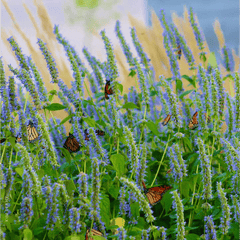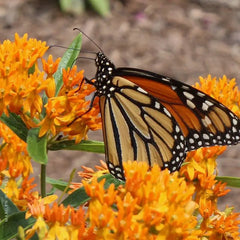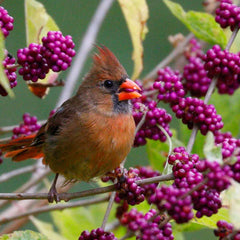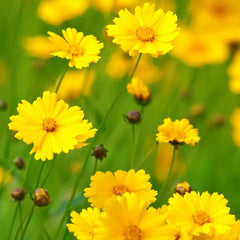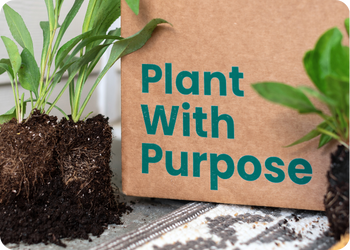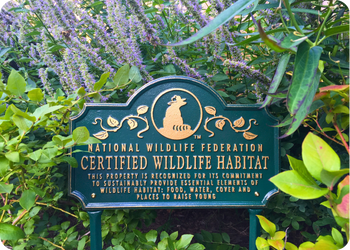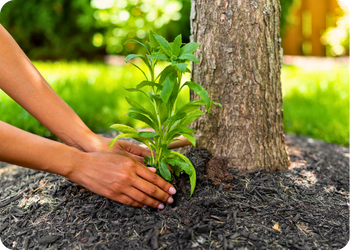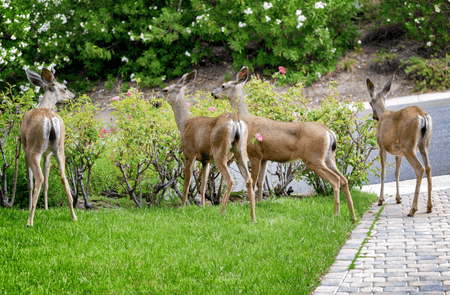Native Plant Terms and What They Really Mean

What is a keystone plant?
A keystone plant for wildlife is a plant species that provides essential resources, such as food, shelter, and nesting sites, for a wide range of local wildlife species. Some popular keystone plant species for wildlife in the US include:
- Oak Trees: Oaks are an important source of food for a variety of wildlife, including birds, squirrels, and deer. They also provide habitat for insects, which in turn provide food for other wildlife species.
- Milkweed: The only host plant for migrating monarch butterflies, it also provides nectar for a variety of pollinators, including bees, butterflies, and hummingbirds.
- Native Grasses (e.g. Little bluestem, purple lovegrass): Native grasses provide cover and nesting sites for a variety of bird species, and their seeds provide food for small mammals and birds.
- Black-eyed Susan: Black-eyed Susans are a popular native wildflower that provide nectar for butterflies and bees and seeds for birds.
- Goldenrod: A keystone species for many pollinators, such as bees, butterflies, and moths. It is an important source of nectar and pollen for many insects, including the endangered Rusty Patched Bumblebee. Helps provide late-season blooms when many other plants have finished flowering.
Native Plant vs. Nativar vs. Cultivar
A native plant is a plant species that is indigenous to a specific geographic region and has evolved over time to adapt to the local climate, soil, and weather conditions. These plants have co-evolved with local wildlife and play an important role in maintaining local ecosystems. Every plant that Garden for Wildlife sells is a straight species native plant. It’s important to know the difference, and know why planting truly native species is so important.
A cultivar is a plant that has been selectively bred for certain characteristics, such as flower color, size, or growth habit. Cultivars may be derived from both native and non-native plant species. While cultivars may have some of the same physical characteristics as their parent plant, they may not be adapted to the local climate or soil conditions, and may not provide the same ecological benefits as true native plants.
A nativar is a plant that is a cultivated variety or hybrid of a native plant. The term "nativar" is a portmanteau of "native" and "cultivar." Nativars are often bred for specific traits, such as flower color or disease resistance, while still retaining some of the characteristics of the native species. While nativars are not considered true native plants, they may still provide some of the same benefits as native plants in terms of supporting local ecosystems.
When mass produced and overused in the landscape industry, the nativars and cultivars result in less genetic diversity than straight species propagated from seed, and therefore provide native plants with less capacity to adapt to stresses ranging from disease to climate change.
In the words of Doug Tallamy, a University of Delaware entomologist and collaborator on our native plant collections, the popularity of nativars shows the extent to which traditional local nurseries or plants stores are “still stuck on the idea of plants as enhanced decoration” rather than as essential to wildlife.
“It is a bad idea to load the landscape with plants that have no genetic variability,” says Tallamy. “I’m not a hardliner on this issue, but gardeners ought to have access to straight species. We have to convince the nursery industry that native plants are about more than just looks.”
What is an invasive plant?
An invasive plant is a non-native species that spreads aggressively and can harm the local ecosystem by outcompeting native plant species, reducing biodiversity, and altering natural habitats. These plants may not have natural predators or diseases in the local ecosystem, which can allow them to grow unchecked and dominate the landscape.
It is important not to plant invasive plants in your garden because they can quickly spread beyond your property and harm the local ecosystem. Invasive plants can be difficult and expensive to control, and can cause damage to natural habitats, agricultural crops, and other plants.
A popular example of an invasive plant that is widely sold at plant stores across the country is the butterfly bush. While pretty, the butterfly bush (Buddleja davidii) is considered invasive in many parts of the United States, especially in western states where it can spread rapidly and outcompete native plants. The plant is native to China and was introduced to the US as an ornamental plant due to its attractive flowers and ability to attract butterflies.
It has been shown to displace other plants and alter habitats. In addition, the plant is not a suitable food source for the caterpillars of many butterfly species, impacting the available habitat for butterflies to reproduce. Due to these negative impacts, some states and municipalities have banned the planting of butterfly bush. Instead, it is recommended to choose native plant species that are well-adapted to local growing conditions and provide food and habitat for a wide variety of wildlife species. Native milkweed is a great alternative if you’re looking to attract butterflies.
If you have invasive plants in your garden, it is recommended to remove them in order to prevent them from spreading and damaging the local ecosystem. There are different methods for removing invasive plants, depending on the species and the extent of the infestation. Some invasive plants can be hand-pulled or dug up, while others may require more extensive removal methods.
What are ornamental plants?
Ornamental plants are selected and grown for their decorative qualities, such as attractive flowers, foliage, or fruits. These plants are often non-native species that have been introduced from other regions of the world, and are chosen for their beauty, adaptability, and ease of cultivation. Ornamental plants are typically used in landscaping and gardening to create visually appealing spaces, add variety to the landscape, and provide interest throughout the year.
While non-native ornamental plants can certainly be beautiful and can add variety to a garden, there are many reasons to consider using native plants instead. Native plants can help support local ecosystems, improve soil health, and reduce water usage in landscaping. They can also require less maintenance than non-native species.
What are exotic plants?
An exotic plant is a non-native plant species that has been introduced to an area outside of its natural range, either intentionally or accidentally. These plants may have been brought to a new region for ornamental, agricultural, or other purposes, or they may have arrived as stowaways on ships or in cargo shipments. Exotic plants can become invasive if they are able to establish self-sustaining populations and outcompete native species, leading to the aforementioned negative effects.
One example of an exotic plant that people should not plant in the US is the Japanese knotweed (Fallopia japonica). This plant is native to Asia, and was introduced to the US in the late 1800s as an ornamental plant. Japanese knotweed is a highly invasive species that can grow up to 10 feet tall and spreads quickly. It can outcompete native plant species, and can even cause damage to roads, buildings, and other structures.
Japanese knotweed is difficult to control once it becomes established, and can require costly and time-consuming efforts to eradicate. Homeowners and gardeners should avoid planting Japanese knotweed or any other known invasive species, and should instead choose native plants that are well-suited to local growing conditions.
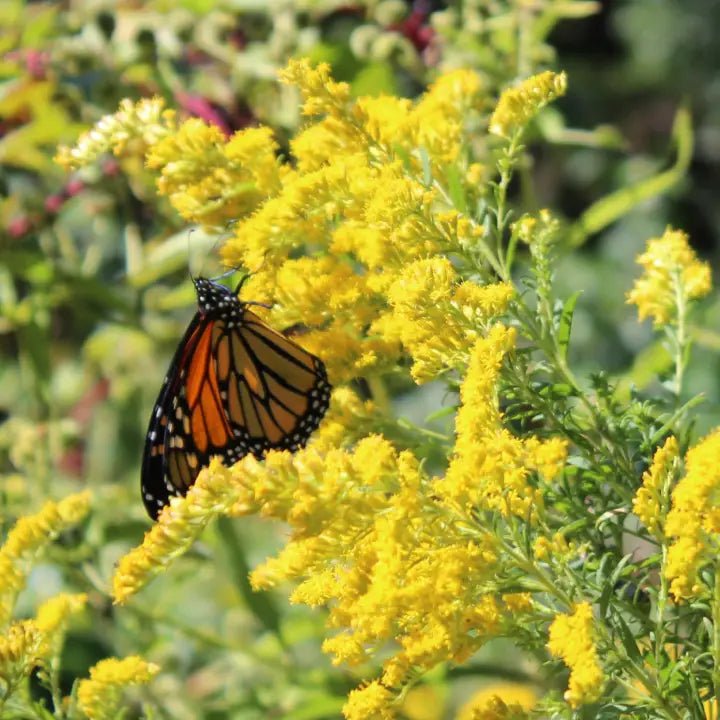
Find Native Plants by Zip Code
We took the guesswork out of planting native. Check your zip to see what ships!
